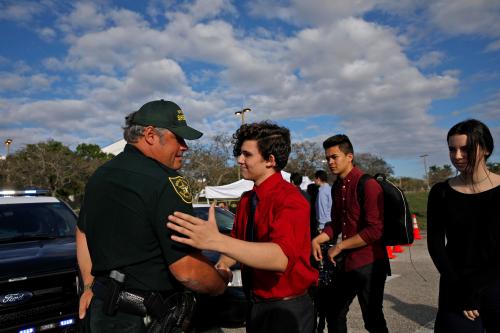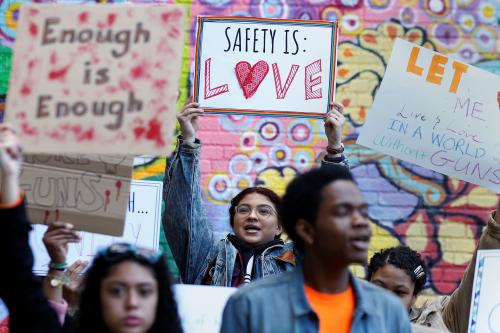On the morning of Nov. 30, 2021, a 15-year-old fatally shot four students and injured seven others at his high school in Oakland County, Michigan. It’s just one of the latest tragedies in a long line of the horrific K-12 school shootings now seared into our memories as Americans.
And we have seen that the threat of school shootings, in itself, is enough to severely disrupt schools. In December, a TikTok challenge known as “National Shoot Up Your School Day” gained prominence. Although vague and with no clear origin, the challenge warned of possible acts of violence at K-12 schools. In response, some schools nationwide cancelled classes, others stepped up security. Many students stayed home from school that day. (It’s worth noting that no incidents of mass violence ended up occurring.)
What are the problems that appear to underlie school shootings? How can we better respond to students that are in need? If a student does pose a threat and has the means to carry it out, how can members of the school community act to stop it? Getting a better grasp of school shootings, as challenging as it might be, is a clear priority for preventing harm and disruption for kids, staff, and families. This post considers what we know about K-12 school shootings and what we might do going forward to alleviate their harms.
Who is perpetrating school shootings?
As the National Association of School Psychologists says, “There is NO profile of a student who will cause harm.” Indeed, any attempt to develop profiles of school shooters is an ill-advised and potentially dangerous strategy. Profiling risks wrongly including many children who would never consider committing a violent act and wrongly excluding some children who might. However, while an overemphasis on personal warning signs is problematic, there can still be value in identifying certain commonalities behind school shootings. These highlight problems that can be addressed to minimize the occurrence of school shootings, and they can play a pivotal role in helping the school community know when to check in—either with an individual directly or with someone close to them (such as a parent or guidance counselor). Carefully integrating this approach into a broader prevention strategy helps school personnel understand the roots of violent school incidents and assess risks in a way that avoids the recklessness of profiling.
Within this framework of threat assessment, exploring similarities and differences of school shootings—if done responsibly—can be useful to prevention efforts. To that end, I recently published a study with colleagues that examined the extent to which features common to school shootings prior to 2003 were still relevant today. We compared the antecedents of K-12 shootings, college/university shootings, and other mass shootings.
We found that the majority of school shooters are male (95%) and white (61%)–yet many of these individuals feel marginalized. Indeed, almost half of those who perpetrate K-12 shootings report a history of rejection, with many experiencing bullying. One 16-year-old shooter wrote, “I feel rejected, rejected, not so much alone, but rejected. I feel this way because the day-to-day treatment I get usually it’s positive but the negative is like a cut, it doesn’t go away really fast.” Prior to the Parkland shooting, the perpetrator said, “I had enough of being—telling me that I’m an idiot and a dumbass.” A 14-year-old shooter stated in court, “I felt like I wasn’t wanted by anyone, especially my mom.” These individuals felt rejected and insignificant.
Our study also found that more than half of K-12 shooters have a history of psychological problems (e.g., depression, suicidal ideation, bipolar disorder, and psychotic episodes). The individuals behind the Sandy Hook and Columbine shootings, among others, had been diagnosed with an assortment of psychological conditions. (Of course, the vast majority of children with diagnosed psychological conditions don’t commit an act of mass violence. Indeed, psychologists and psychiatrists have warned that simply blaming mental illness for mass shootings unfairly stigmatizes those with diagnoses and ignores other, potentially more salient factors behind incidents of mass violence.) For some, the long-term rejection is compounded by a more acute rejection experience that immediately precedes the shooting. While K-12 school shooters were less likely than other mass shooters to experience an acute, traumatic event shortly before the shooting, these events are not uncommon.
Many shooters also display a fascination with guns and/or a preoccupation with violence. They play violent video games, watch violent movies, and read books that glorify violence and killing. Several of the shooters showed a particular fascination with Columbine, Hitler, and/or Satanism. They wrote journals or drew images depicting violence and gore. The continued exposure to violence may desensitize individuals to violence and provide ideas that are then copied in the school shootings.
To reiterate, however, there is no true profile of a school shooter. Plenty of people are bullied in middle and high school without entertaining thoughts of shooting classmates. Similarly, making and breaking relationships goes along with high school culture, yet most people who experience a break-up do not think of harming others. Anxiety and depression are common, especially in adolescence, and countless adolescents play violent video games without committing acts of violence in real life. Even if some commonalities are evident, we must recognize their limits.
What can we do?
Understanding the experiences of school shooters can reveal important insights for discerning how to prevent school shootings. So, what might we do about it?
First, the problems that appear to underlie some school shootings, such as bullying and mental-health challenges, need attention—and there’s a lot we can do. School administrators and educators need to implement bullying prevention programs, and they need to pay attention to the mental-health needs of their students. One way to do this is to facilitate “psychological mattering” in schools. Students who feel like they matter—that they are important or significant to others—are less likely to feel isolated, ostracized, and alone. They feel confident that there are people to whom they can turn for support. To the extent that mattering is encouraged in schools, bullying should decrease. Typically, we don’t bully people who are important or significant to us.
Second, because most of the perpetrators of K-12 shootings are under the age of 18, they cannot legally acquire guns. In our study, handguns were used in over 91% of the K-12 shootings, and almost half of the shooters stole the gun from a family member. Without guns, there cannot be school shootings. Clearly more needs to be done to keep guns out of the hands of youth in America.
Third, students, staff, and parents must pay attention to explicit signals of an imminent threat. Many shooters leak information about their plans well before the shooting. They may create a video, write in a journal, warn certain classmates not to attend school on a particular day, brag about their plans, or try to enlist others’ help in their plot. Social media has provided a venue for children to disclose their intentions. Yet, students, parents, and educators often ignore or downplay the warning signs of an imminent threat. Students often think their peers are simply expressing threats as a way of garnering attention. Even if the threats are taken seriously, an unwritten code of silence keeps many students from reporting what they see or hear. They don’t want to be a snitch or risk being the target of the would-be shooter’s rage. With this in mind, educators and administrators need to encourage reporting among students—even anonymously—and need to take those reports extremely seriously. Helpful information for teachers, administrators, and parents can be found at SchoolSafety.gov. In addition, Sandy Hook Promise provides information about school violence and useful videos for young people about attending to the warning signs that often accompany school shootings.
Fourth, school leaders should be aware that not every apparent act of prevention is worth the costs. Some people believe that lockdown drills, metal detectors, school resource officers, and the like are useful deterrents to school shootings and school violence more broadly. However, researchers have also demonstrated that they can increase anxiety and fear among students. Students may also become habituated to the drills, failing to recognize the seriousness of an actual threat should it arise. Additionally, most K-12 shooters are students within the school itself. These students are well-versed in the security measures taken by the school to try to deter acts of violence by individuals such as themselves. While few would suggest getting rid of lockdown drills and other security measures, educators and administrators need to be mindful of the rewards versus the costs in their selection of safety measures.
Ultimately, our goal should be creating an environment in which school shootings never occur. This is an ambitious aim, and it will be challenging work. But addressing some key issues, such as mental health, will go a long way toward preventing future tragedies in our schools. As so aptly demonstrated in the Ted Talk, “I was almost a school shooter,” by Aaron Stark, making someone feel that they have value and that they matter can go a long way toward altering that individual’s life and, consequently, the lives of others.






Commentary
School shootings: What we know about them, and what we can do to prevent them
January 26, 2022